February 2025
The global portable ultrasound bladder scanner market size accounted for USD 281.84 million in 2024, grew to USD 292.97 million in 2025 and is projected to surpass around USD 415.19 million by 2034, representing a CAGR of 3.95% between 2024 and 2034. The North America portable ultrasound bladder scanner market size is calculated at USD 98.64 million in 2024 and is expected to grow at a CAGR of 4.08% during the forecast year.
The global portable ultrasound bladder scanner market size is worth around USD 281.84 million in 2024 and is anticipated to reach around USD 415.19 million by 2034, growing at a CAGR of 3.95% from 2024 to 2034. The increasing prevalence of urological diseases like urinary infections & incontinence, and bladder cancers are driving the portable ultrasound bladder scanner market. Additionally, increased demand for point-of-care diagnostics is contributing to the market expansion. With the rising adoption of cutting-edge medical devices in healthcare, the market is expected to boost in the forecast period.
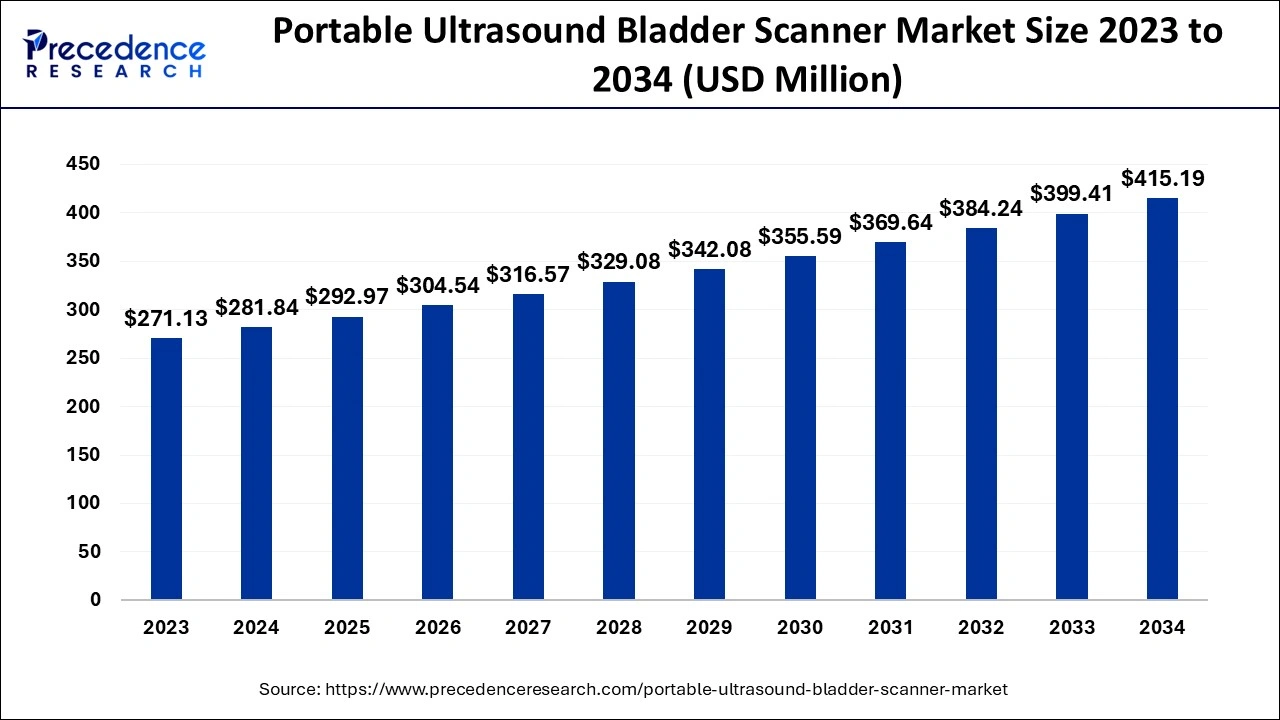
The adoption of AI-powered devices is rapidly transforming the portable ultrasound bladder scanner market. AI is enabled to provide enhanced accuracy, automated image analysis, improved efficiency, remote monitoring, and data-driven analysis. AI can analyze large databases and provide real-time decision-making support. AI-enabled portable ultrasound bladder scanners allow personalized insights and help medical professionals to understand and recommend treatment plans or real-time health conditions of the patients.
Lately, AI is transforming the portable ultrasound bladder scanner market by providing advancements in point-of-care ultrasound (POCUS), enabling further novel opportunities for medical diagnosis in low-resource settings. Additionally, AI is enabled to meet regulatory compliance and standards. Regulatory framework initiatives are encouraging the adoption of AI in the industry. Manufacturers are becoming more confident in the development of innovative AI-enabled portable ultrasound bladder scanners due to regulatory bodies' focus on promoting standardization and encouraging innovations.
The U.S. portable ultrasound bladder scanner market size is evaluated at USD 69.05 million in 2024 and is expected to be worth around USD 103.91 million by 2034, growing at a CAGR of 4.15% from 2024 to 2034.
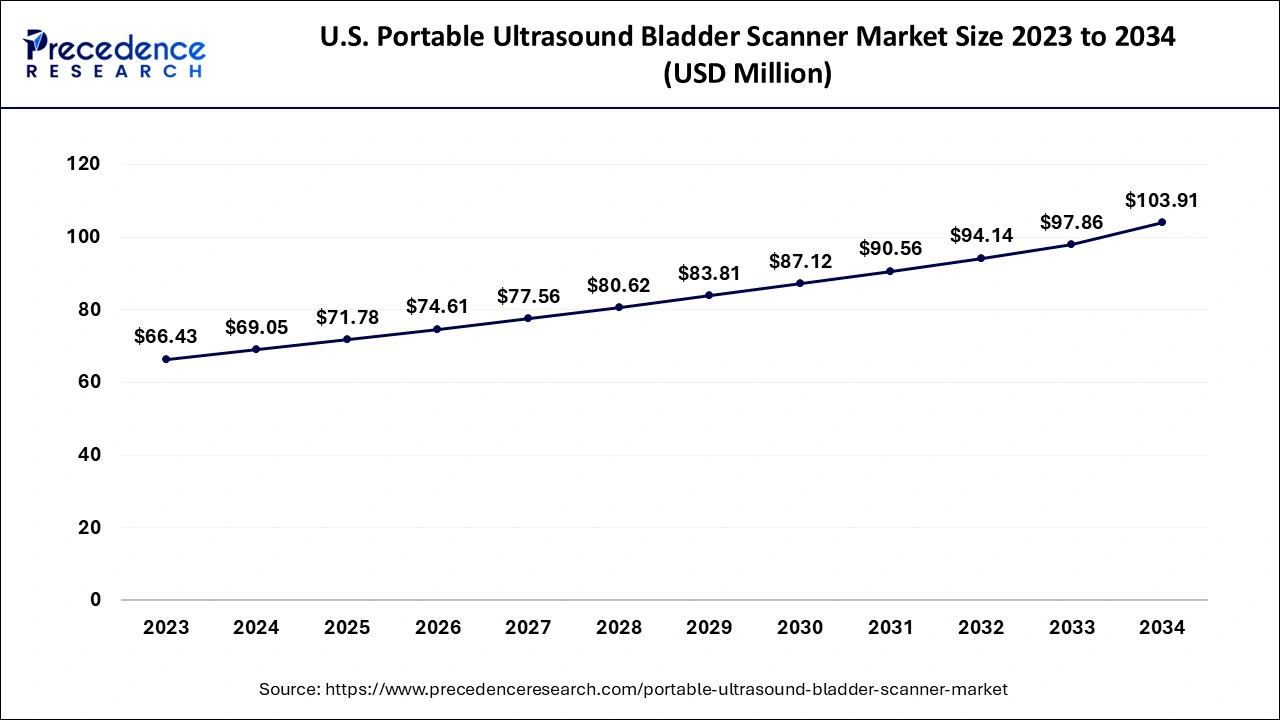
North America led the global portable ultrasound bladder scanner market in 2023. The well-established healthcare sector in the region allows people to access cutting-edge diagnostics. Moreover, the region is well known for its development and adoption of advanced technologies. The adoption of cutting-edge portable ultrasound bladder scanners in healthcare is enhancing the economy and healthcare infrastructure. The government and non-government bodies are investing in providing better healthcare in the region.
The United States is leading the portable ultrasound bladder scanner market with the presence of advanced healthcare infrastructure and government and regulatory framework initiatives. The growing integration of robotics and AI in the medical sector is one of the key factors behind countries' contributions to market growth. With favorable reimbursement policies and patients' concerns for health, the market in the United States is projected to expand continuously.
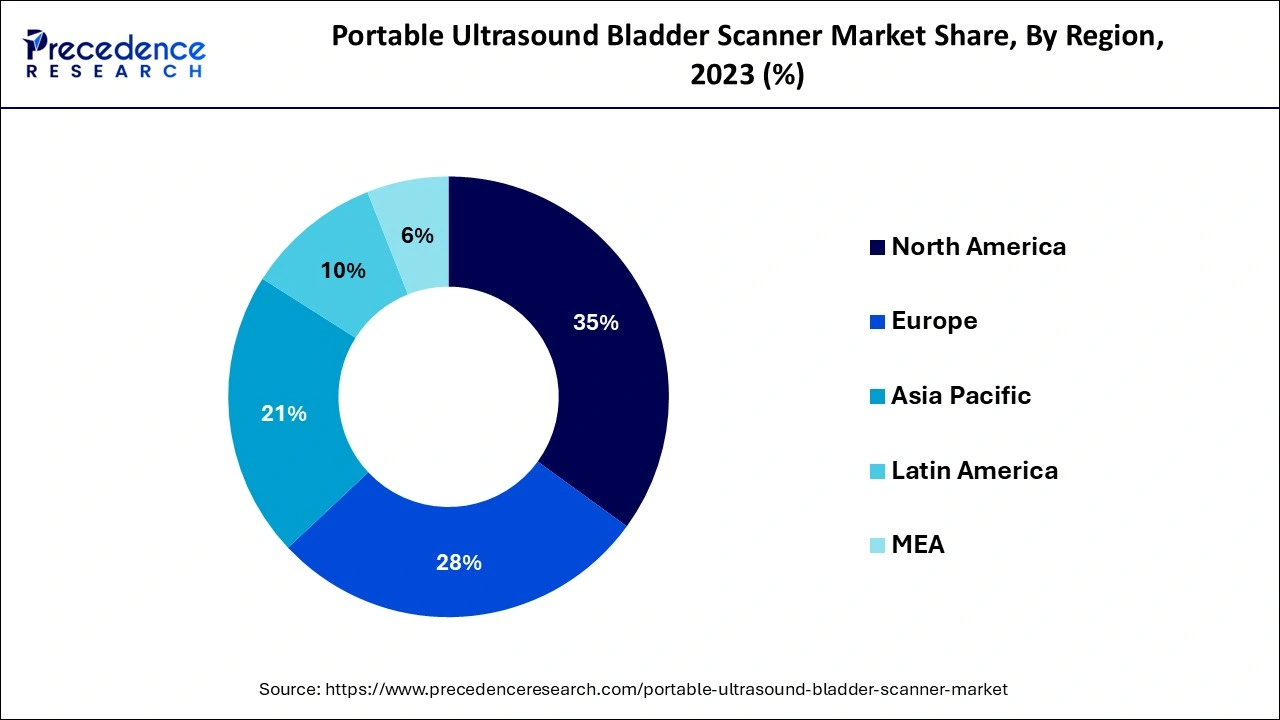
Asia Pacific is anticipated to witness significant growth in the portable ultrasound bladder scanner market during the forecasted years. The large population is the key factor driving the growth of the portable ultrasound bladder scanner market in the region. The growing prevalence of urinary infections, benign prostatic hyperplasia (BPH), and bladder cancers is driving patient loops in hospitals. Additionally, growing, expanding healthcare infrastructure is contributing to the adoption of advanced technologies like portable ultrasound bladder scanners.
China has generated the biggest share in the portable ultrasound bladder scanner market due to its major patient loop and expanded advanced healthcare sector. However, India is driving market growth due to favorable health policies supporting the adoption and research and the development of cutting-edge technologies. With government support for local manufacturers to provide cost-effective accessibility of advanced technologies to middle-class people, investment in research & developments is likely to fuel the market expansion in the forecast period.
Portable ultrasound ladder scanner devices are transportable ultrasound devices that utilize automated technology to register bladder volume digitally, such as PVR volume, and provide 3D/4D images. The growing prevalence of urological disorders, the adoption of portable and handheld devices, and the growing demand for non-invasive diagnostic procedures are the factors contributing to the expanded growth of the portable ultrasound bladder scanner market. The growing importance of early detection and disease management is driving the demand for non-invasive tools in diagnostics. The real-time assessment of bladder scanners has generated space among medical professionals.
Home-care diagnostic settings and remote monitoring culture have gained preference during the COVID-19 pandemic. The continuous development of reliable and comfortable diagnostic devices and services is highlighting the growth of healthcare. Growing demands for advanced healthcare services like point-of-care ultrasound (POCUS) and 3D imaging/4D imaging ultrasounds are increasing the market competition. Additionally, with expanding healthcare infrastructure, the adoption of cutting-edge technologies in healthcare, and government and regulatory frameworks, the market is witnessing steady growth. Moreover, the government's worldwide determination to provide cutting-edge health services and benefits to undeveloped and rural areas is holding great market potential.
| Report Coverage | Details |
| Market Size by 2034 | USD 415.19 Million |
| Market Size in 2024 | USD 281.84 Million |
| Market Size in 2025 | USD 292.97 Million |
| Market Growth Rate from 2024 to 2034 | CAGR of 3.95% |
| Largest Market | North America |
| Base Year | 2023 |
| Forecast Period | 2024 to 2034 |
| Segments Covered | Product Type, End-user, and Regions |
| Regions Covered | North America, Europe, Asia-Pacific, Latin America, and Middle East & Africa |
Technology advancements
Advancements in technology are driving the growth of the portable ultrasound bladder scanner market. Advancements in ultrasound technology, like improved image quality and accuracy, are driving adoptions by healthcare professionals to provide more accurate diagnoses to patients. Moreover, the development of cutting-edge handheld ultrasound devices and their portability are gaining in popularity. The demand for wireless devices like electronic health records (EHRs), communication systems (PACS), and picture archiving is emerging in the market.
The integration of automation and IoT technologies like remote monitoring, data analytics, and cloud computing allows accessibility to real-time patient health, recommended diagnostics, and accurate visibility. The integration of cutting-edge technologies is proving the accessibility of advanced healthcare services in undeveloped and rural areas. Additionally, developments of advanced services like point-of-care ultrasounds, 3D/4D imaging, and contrast-powered ultrasounds are improving visibility, reducing hospitalizations, and enabling more accuracy.
Strict regulations
Strict regulatory frameworks like FDA, CE Marking, and ISO standards are likely to hamper the market growth. In the United States, the products are required to be cleared by the Food & Drug Administration (FDA), which is a costly and time-consuming process. CE marking is a European regulatory requirement for the approval of products; portable ultrasound bladder scanners also need to meet medical device regulation standards as per the regulatory requirements. Similarly, ISO standards ask for the devices to comply with quality management systems. Moreover, regulatory compliance, including clinical trials, labeling, and post-market surveillance, impacts market growth. Such regulation leads to delays in the market entry of products, increases costs, and challenges manufacturers with further developments.
Personal home care settings
The adoption of advanced technologies in healthcare has allowed for real-time monitoring and remote treatments. As the prevalence of urological diseases has increased among the aging population, the demand for home care services has increased as well. Patients are continuously looking for self-care and home services for elderly patients, as it is more comfortable for them than being hospitalized. Portable ultrasound bladder scanners are user-friendly and easy to handle and undergo in examinations, making them preferable among elderly patients.
The awareness for early detection & prevention is playing a significant role in the demand for home-care diagnostic settings. The ideal personal home care setting helps patients reduce possible costs and provide more comfort. With the availability of advanced technologies to remotely monitor patient health for medical professionals, user-friendly features are creating popularity in personal home care settings. As a result, opportunities for innovative development and integrations with telehealth platforms are likely to be generated.
The 2D segment accounted for the highest share of the portable ultrasound bladder scanner market in 2023. The 2D segment led the market due to its convenient use for regular exams and quick evaluations. The segment is witnessing significant growth due to its affordable property with dependency on accurate and quick bladder value measurements and accessibilities with other options for healthcare providers. Additionally, the segment is enabled to provide entire real-time images, which helps to understand the required diagnoses for medical professionals. Due to the developments in enhanced 2D portable ultrasound bladder scanners with improved image quality and accuracy, the healthcare sector has increased its adoption.
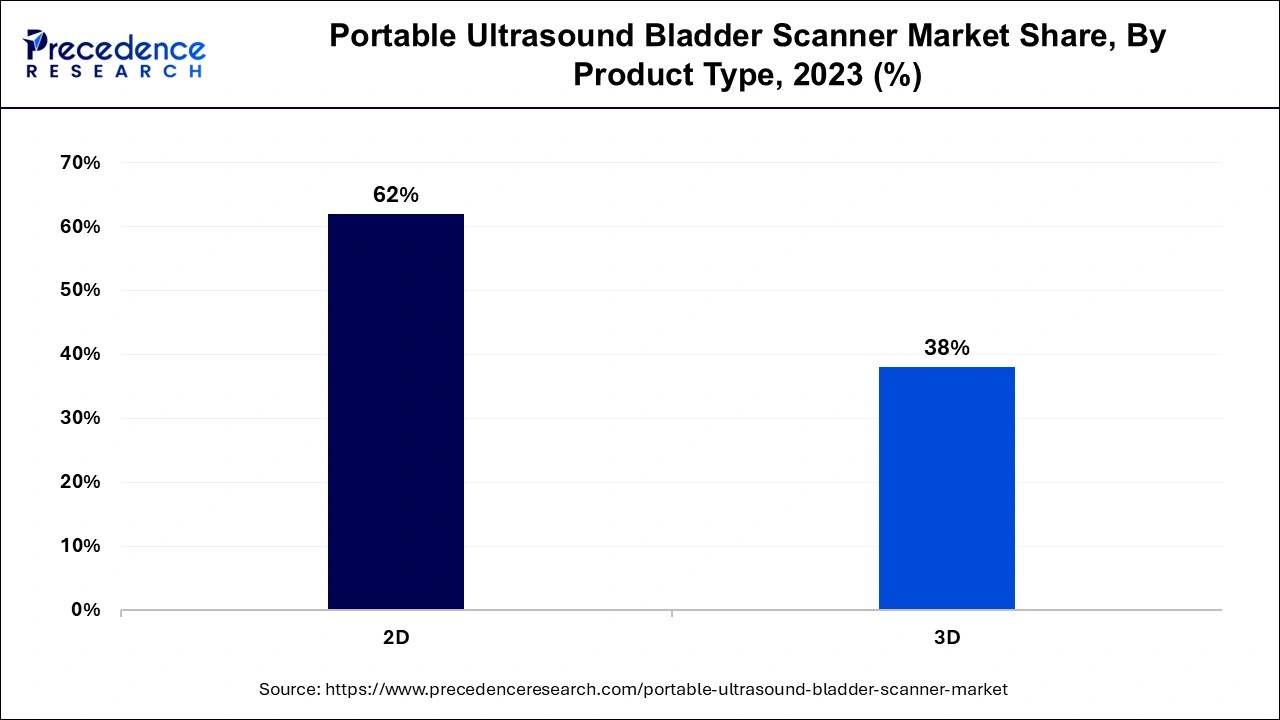
The 3D segment will grow rapidly in the portable ultrasound bladder scanner market during the forecast period. The enhanced visibility capabilities of the 3D portable ultrasound bladder scanner are making them popular among healthcare professionals. The growing prevalence of urinary incontinence is increasing the need for improved accuracy and assessable bladder volume and anatomy in 3D. 3D scanners reduce the need for double or multiple scans as they provide exact accuracy, making them more convenient and comfortable for the patient. Due to the ability of invasive processes and improved visualization and diagnostic accuracy.
The hospital segment led the global portable ultrasound bladder scanner market in 2023. The growing adoption of point-of-care testing and treatments is the major factor driving the growth of the hospital segment in the market. The growing prevalence of urinary infections and incontinence is increasing hospitalization. Growing government initiatives are encouraging the development of innovative medical devices in healthcare firms. Hospitals are continuously focusing on the adoption of enhanced portable ultrasound bladder scanners to improve diagnostic capabilities and provide comfort to patients. User-friendly medical devices, including portable ultrasound bladder scanners for enhanced accuracy, quick testing, and exact recommendations of diagnostics, are highly required in hospitals.
The diagnostic imaging centers segment will witness the fastest growth in the portable ultrasound bladder scanner market during the predicted period due to the growing need for accurate treatments and the rapidly growing prevalence of chronic disease. Advanced imaging technologies allow accuracy and efficiency in diagnostic procedures, making them more popular in diagnostic imaging centers. Easy to use, compact size, user-friendly features, and affordability are the factors increasing the adoption of portable ultrasound bladder scanners in diagnostic imaging centers.
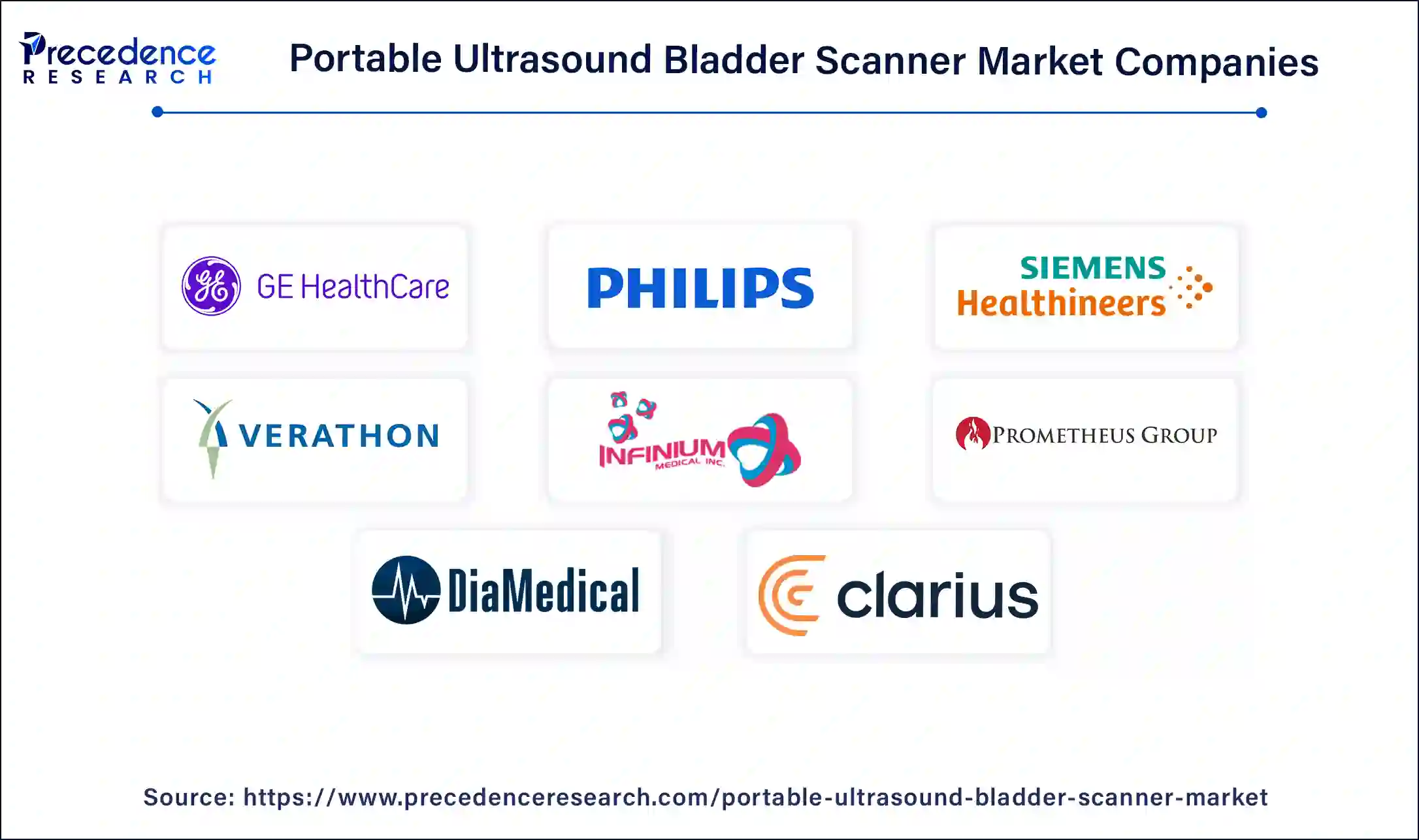
By Product Type
By End-user
By Geography
For inquiries regarding discounts, bulk purchases, or customization requests, please contact us at sales@precedenceresearch.com
No cookie-cutter, only authentic analysis – take the 1st step to become a Precedence Research client
February 2025
November 2024
November 2024
August 2024